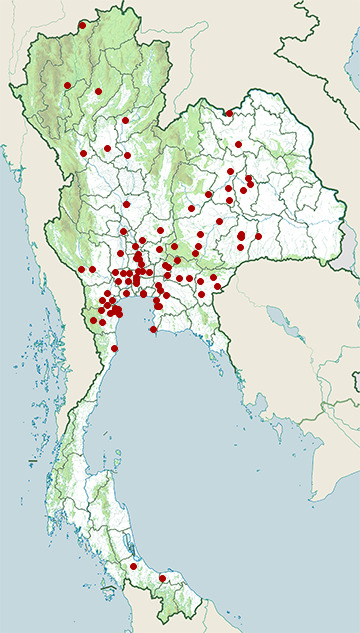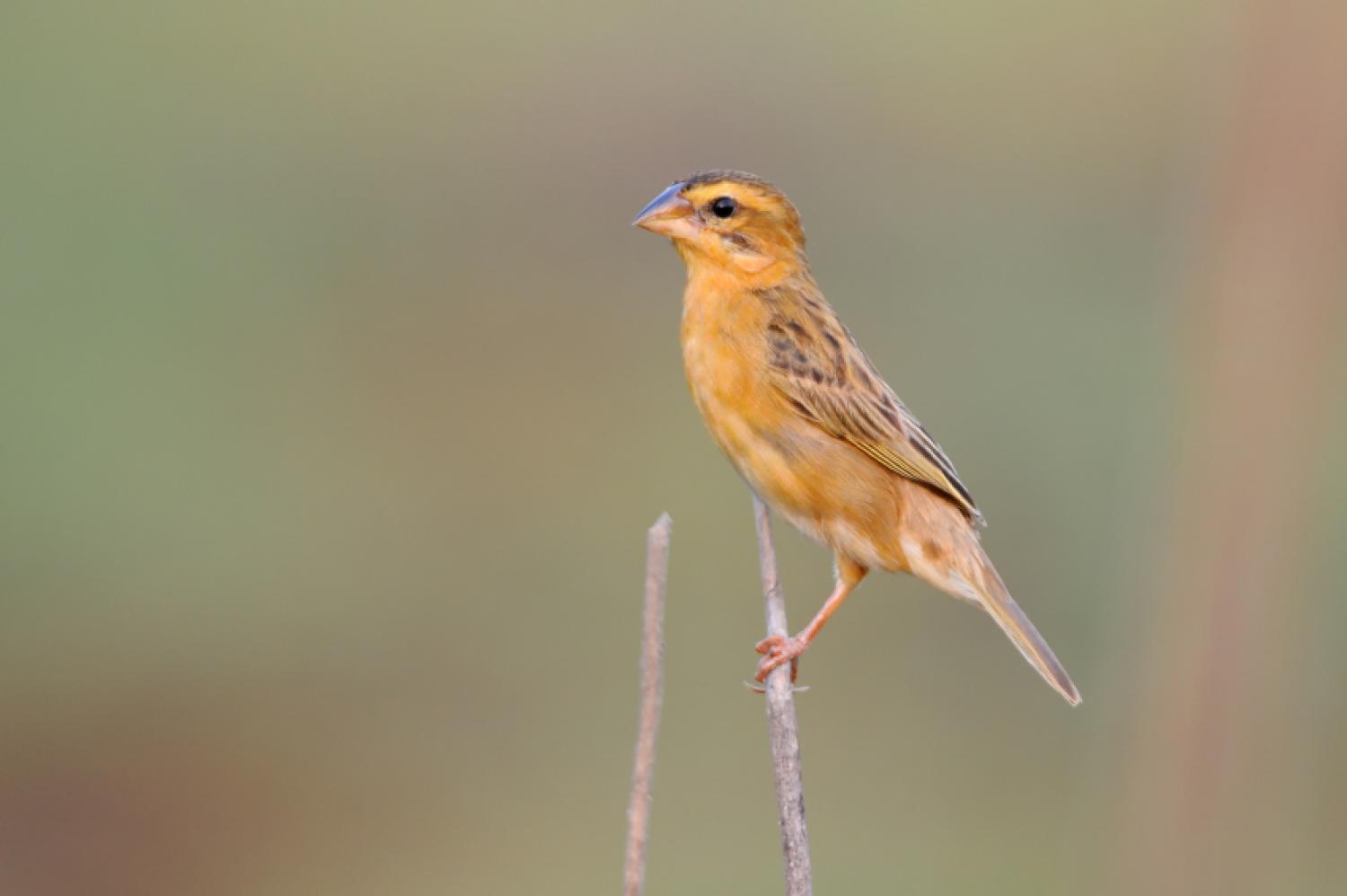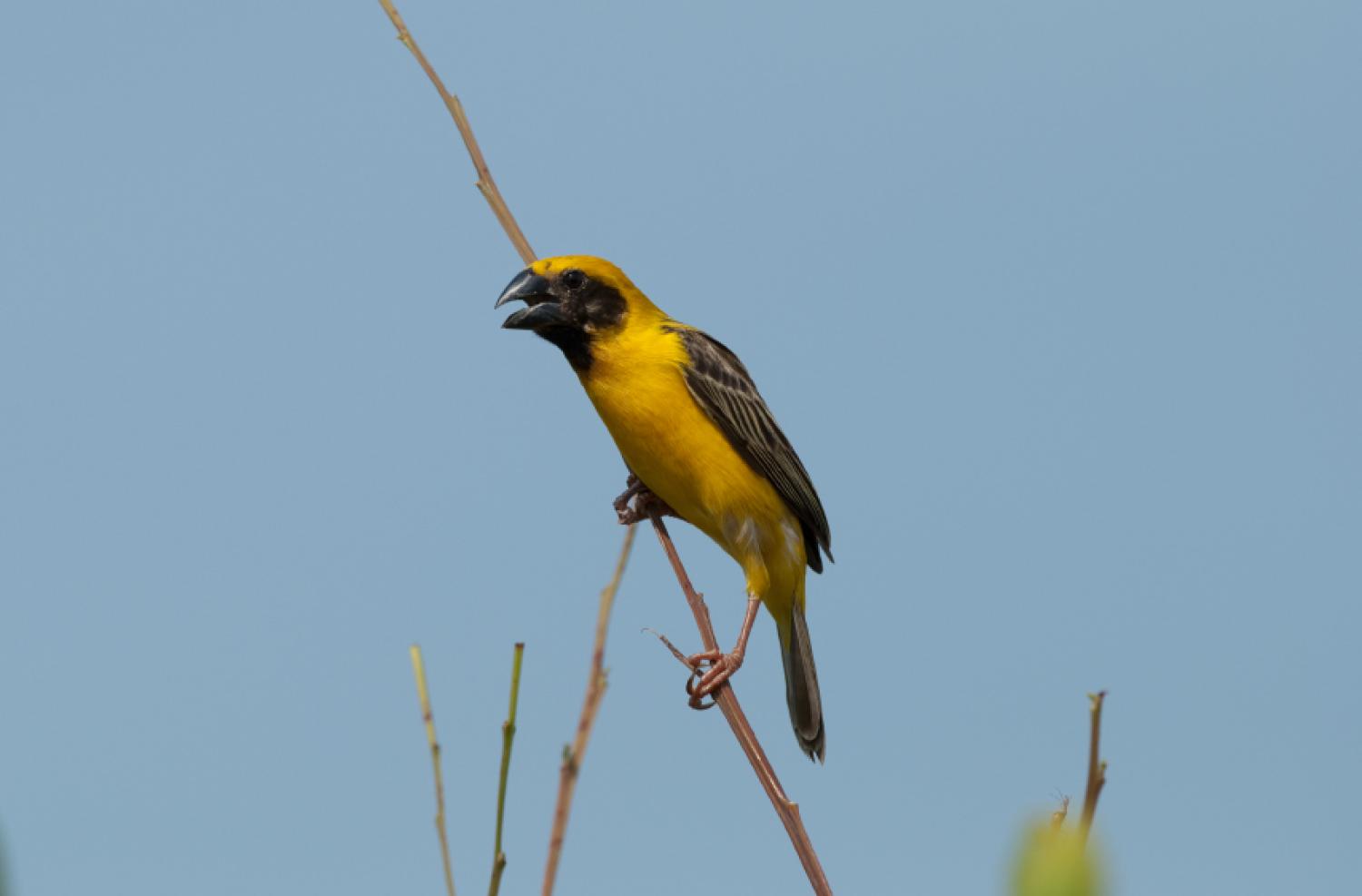Species of Thailand
Asian golden weaver
Ploceus hypoxanthus
Anders Sparrman, 1788
In Thai: นกกระจาบทอง
The Asian golden weaver (Ploceus hypoxanthus) is a species of bird in the family Ploceidae.
It is found in Cambodia, Indonesia, Laos, Myanmar, Thailand, and Vietnam.
Its natural habitats are subtropical or tropical seasonally wet or flooded lowland grassland, swamps, and arable land.
It is threatened by habitat loss.
Historical background
The Asian Golden Weaver was initially named and discovered by Anders Erikson Sparrman, a Swedish naturalist. Although Sparrman sailed around the world with James Cook, starting from Cape Town, on Cook's second expedition to the Pacific (1772–1775), they did not visit islands as far north as Sumatra. After the voyage Sparrman returned to Cape Town in July 1775 and practiced medicine. In 1776 he returned to Sweden and published a Catalogue of the Museum Carlsonianum (1786–89), in which he described many of the specimens he had collected in South Africa and the South Pacific, some of which were new to science. As a result, he wrote a Latin description of the Asian Golden Weaver.
Description
The breeding male is generally bright yellow with a black mask (diagnostic in Asia). Females, non-breeding males and young birds are dull coloured and difficult to distinguish from the Baya Weaver, with their thicker bills being the only thing that sets them apart. In general, Asian golden weavers are considered medium-sized birds with yellow and black upperparts, along with yellow underparts. They possess a black face, yellow crown, a strong black bill, and have an average length of 22 centimeters.
Distribution
There are two distinct subspecies of the Asian golden weaver, and these include the P. h. hypoxanthus, found in Indonesia: eastern Sumatra and western Java, and the P. h. hymenaicus, found in Myanmar (including Tenasserim), Thailand, Laos, Cambodia and southern Vietnam This subspecies has the feathers of the mantle fringed with a more greenish yellow, and has the upper breast more strongly suffused with raw sienna.
The Asian Golden Weaver was formerly more ordinary in the areas of Java and Sumatra, but it is now localized and considered rare in today's age. Its population is showing a continued decline throughout its range as wetlands are converted to agriculture. There is also direct persecution and capture of these weavers for the bird trade, and colonies are often robbed and destroyed by people. The oldest bird is 11 years of age.
Behavior and ecology
Asian golden weavers are primarily presumed residents, meaning they are often found in their most comfortable locations. The most common habitats of the Asian golden weaver would include the lowlands, usually those with a close proximity to water; some of these areas would involve marshes, rice paddies, flooded grasslands, and swamps. In addition, this weaver feeds mainly on seeds, and during breeding, insects usually account for only 7% of their diet.
While this weaver is not threatened on a global scale, it still possesses a conservation status of Near Threatened, due primarily to a moderate population decline.
Breeding and nesting
It is widely believed that the Asian Golden Weaver is monogamous, with some rare cases of polygamy. It breeds in small colonies, and the nest is initially created by the male, and completed with assistance of the female. The nest is a rounded structure with a side entrance, and woven from thin strips of grass or palm leaves. Nests are firmly attached to vegetation over water or very swampy ground, often less than 1m above the surface, usually in reeds or bulrushes. Sometimes nests are placed in trees or shrubs, and then higher than 2 m above the ground. There are several records of nests built close to hornet nests or near biting ants.
The average clutch size ranges from two to three eggs, and these eggs often have a greyish-white color. While being grown, the eggs can also grow to an average size of 188 mm by 13.5 mm. Incubation is done by the female only, and upon hatching, the chicks are fed mainly by the female, with occasional assistance by the male.
This article uses material from Wikipedia released under the Creative Commons Attribution-Share-Alike Licence 3.0. Eventual photos shown in this page may or may not be from Wikipedia, please see the license details for photos in photo by-lines.
Category / Seasonal Status
BCST Category: Recorded in an apparently wild state within the last 50 years
BCST Seasonal status: Resident or presumed resident
Scientific classification
- Kingdom
- Animalia
- Phylum
- Chordata
- Class
- Aves
- Order
- Passeriformes
- Family
- Ploceidae
- Genus
- Ploceus
- Species
- Ploceus hypoxanthus
Common names
- Thai: นกกระจาบทอง
Conservation status

Near Threatened (IUCN3.1)

Near Threatened (BirdLife)
(BCST)
- (Recent expansion suggests global threat level exaggerated) -
Photos
Please help us review the bird photos if wrong ones are used. We can be reached via our contact us page.
Range Map

- Amphawa District, Samut Songkhram
- Aranyaprathet District, Sa Kaeo
- Ban Laem District, Phetchaburi
- Ban Lat District, Phetchaburi
- Ban Phai District, Khon Kaen
- Ban Pho District, Chachoengsao
- Ban Sang District, Prachinburi
- Bang Ban District, Phra Nakhon Si Ayutthaya
- Bang Len District, Nakhon Pathom
- Bang Pa In District, Phra Nakhon Si Ayutthaya
- Bang Pahan District, Phra Nakhon Si Ayutthaya
- Bang Phra Non-Hunting Area
- Bang Pu Recreation Centre
- Bangkok Province
- Borabue District, Maha Sarakham
- Bueng Boraped Non-Hunting Area
- Bueng Boraphet Non-Hunting Area
- Chaiyo District, Ang Thong
- Chatturat District, Chaiyaphum
- Doi Lo District, Chiang Mai
- Doi Pha Hom Pok National Park
- Hat Yai District, Songkhla
- Huai Chorakhe Mak Reservoir Non-Hunting Area
- Huai Talat Reservoir Non-Hunting Area
- Kabin Buri District, Prachinburi
- Kaeng Khoi District, Saraburi
- Kaeng Krachan District, Phetchaburi
- Kaeng Krachan National Park
- Kamphaeng Saen District, Nakhon Pathom
- Kantharawichai District, Maha Sarakham
- Khao Khiao - Khao Chomphu Wildlife Sanctuary
- Khao Sam Roi Yot National Park
- Khao Yai National Park
- Khao Yoi District, Phetchaburi
- Khlong Luang District, Pathum Thani
- Khok Pho District, Pattani
- Kumphawapi District, Udon Thani
- Laem Pak Bia
- Mueang Buriram District, Buriram
- Mueang Chachoengsao District, Chachoengsao
- Mueang Chonburi District, Chonburi
- Mueang Kanchanaburi District, Kanchanaburi
- Mueang Khon Kaen District, Khon Kaen
- Mueang Lampang District, Lampang
- Mueang Lopburi District, Lopburi
- Mueang Maha Sarakham District, Maha Sarakham
- Mueang Nakhon Nayok District, Nakhon Nayok
- Mueang Nakhon Pathom District, Nakhon Pathom
- Mueang Nakhon Ratchasima District, Nakhon Ratchasima
- Mueang Nong Khai District, Nong Khai
- Mueang Nonthaburi District, Nonthaburi
- Mueang Phetchaburi District, Phetchaburi
- Mueang Phitsanulok District, Phitsanulok
- Mueang Ratchaburi District, Ratchaburi
- Mueang Sa Kaeo District, Sa Kaeo
- Mueang Samut Sakhon District, Samut Sakhon
- Mueang Sukhothai District, Sukhothai
- Mueang Suphanburi District, Suphan Buri
- Mueang Surin District, Surin
- Mueang Tak District, Tak
- Mueang Uttaradit District, Uttaradit
- Nong Song Hong District, Khon Kaen
- Nong Waeng Non-Hunting Area
- Nong Ya Plong District, Phetchaburi
- Pa Sak Chonlasit Dam Non-Hunting Area
- Pak Chong District, Nakhon Ratchasima
- Pak Kret District, Nonthaburi
- Pak Phli District, Nakhon Nayok
- Pak Thale
- Pak Tho District, Ratchaburi
- Pak Thong Chai District, Nakhon Ratchasima
- Phanat Nikhom District, Chonburi
- Phimai District, Nakhon Ratchasima
- Phra Nakhon Si Ayutthaya District, Phra Nakhon Si Ayutthaya
- Phutthamonthon District, Nakhon Pathom
- Sai Noi District, Nonthaburi
- Sai Yok District, Kanchanaburi
- Sakaerat Environmental Research Station
- Samut Prakan Province
- Sanam Bin Reservoir Non-Hunting Area
- Sankhaburi District, Chainat
- Sattahip District, Chonburi
- Si Maha Phot District, Prachinburi
- Thanyaburi District, Pathum Thani
- Wang Nam Yen District, Sa Kaeo
- Wat Phai Lom & Wat Ampu Wararam Non-Hunting Area
- Watthana Nakhon District, Sa Kaeo

